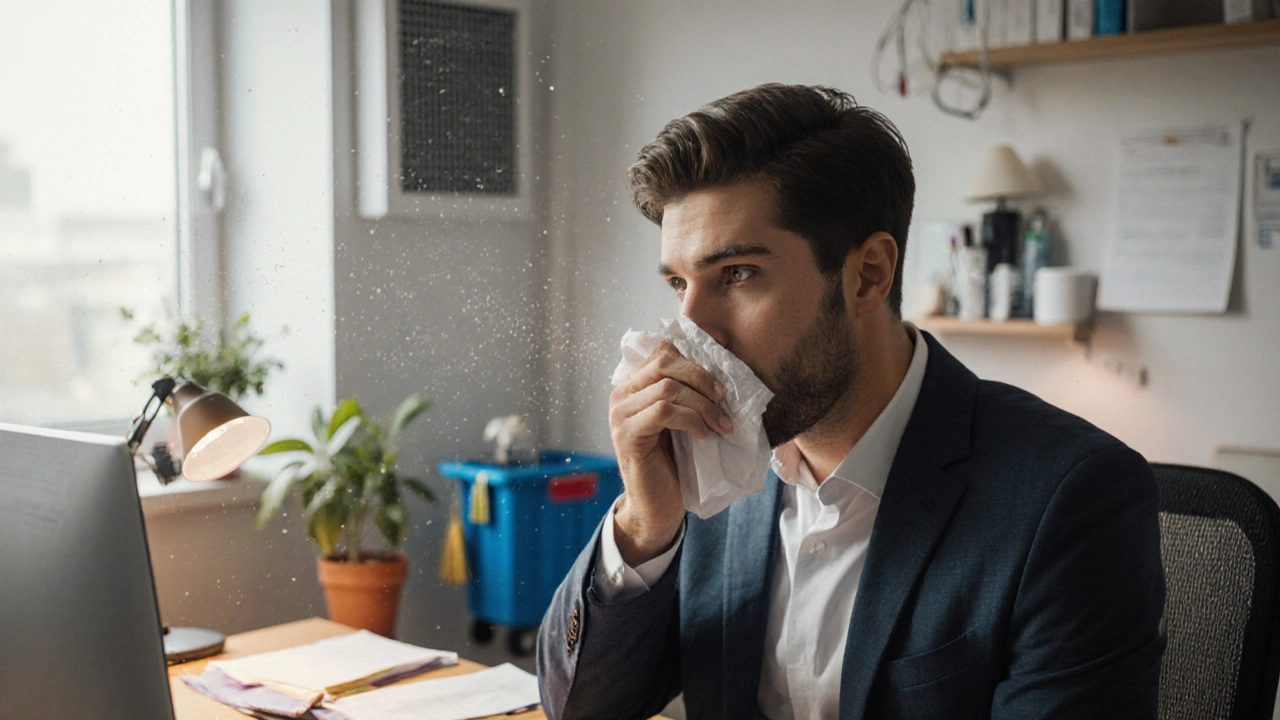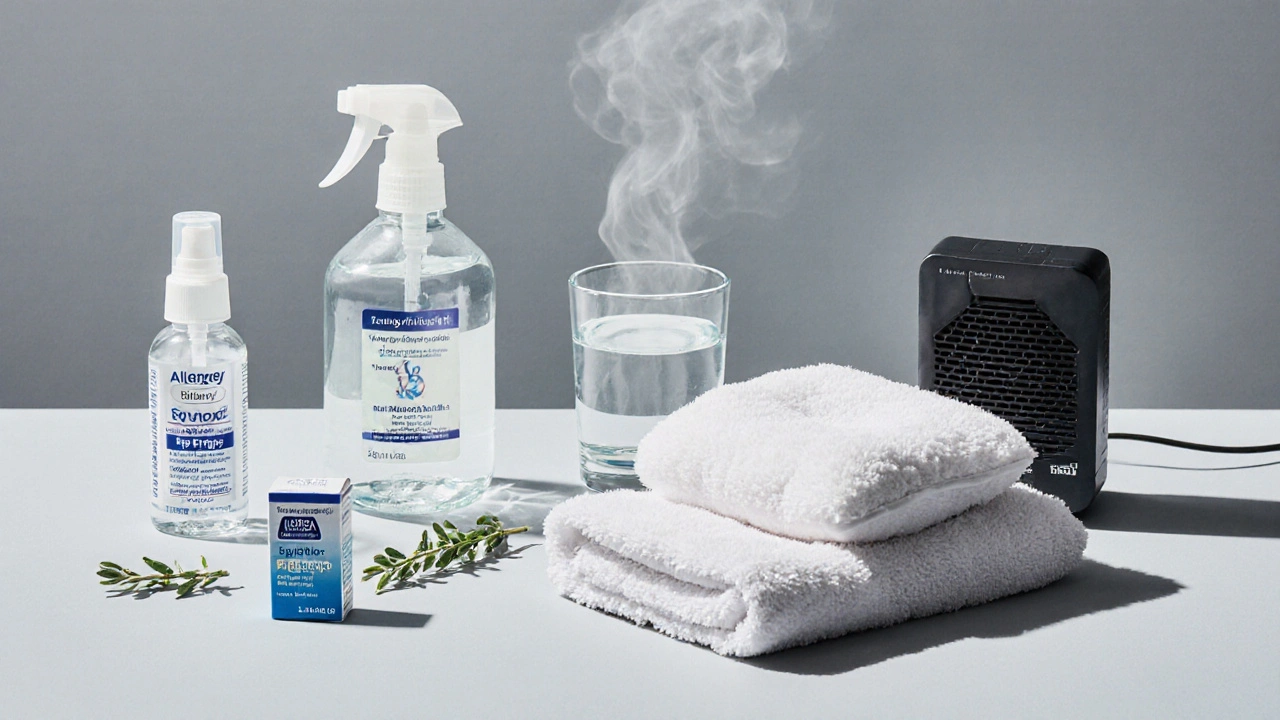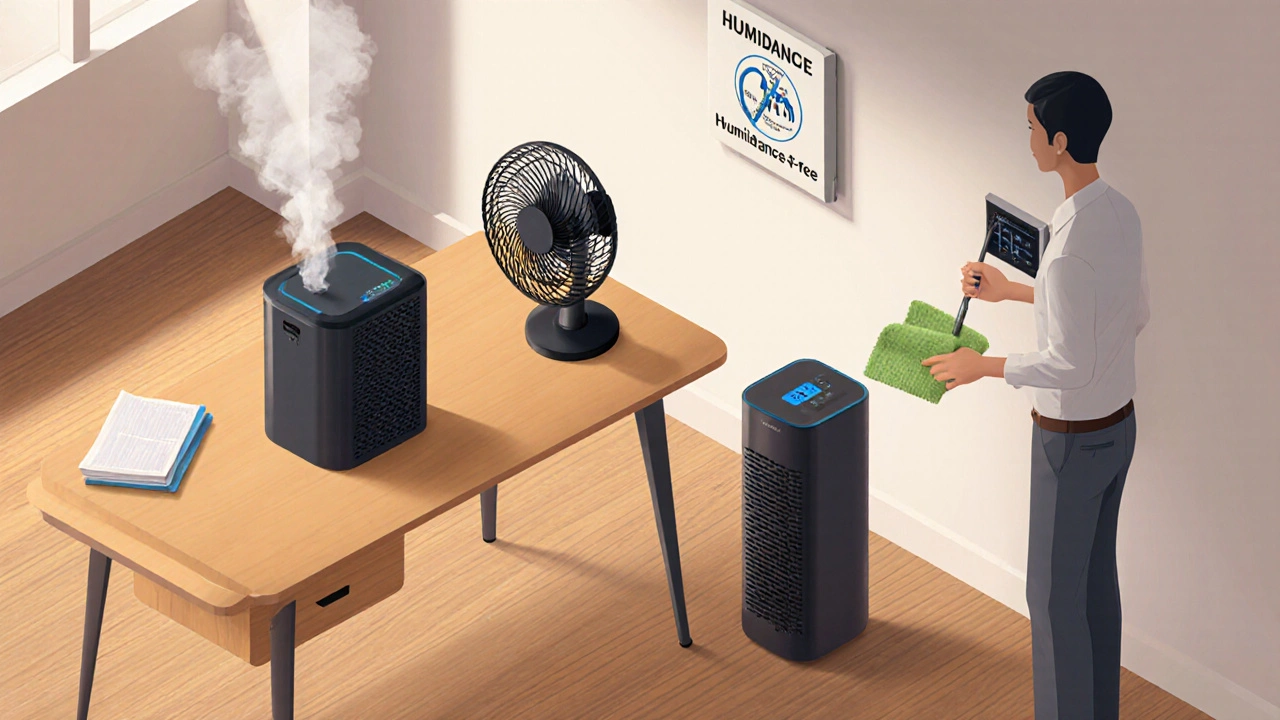Effective Ways to Manage a Blocked Nose and Red Watery Eyes at Work

Workplace Allergy Trigger Checker
This tool helps identify workplace allergens contributing to your symptoms. Answer the questions below to get personalized relief recommendations.
Your personalized recommendations will appear here based on your answers.
Ever found yourself sneezing, rubbing watery eyes, and struggling to breathe through a stuffy nose while trying to finish a deadline? That uncomfortable combo can turn a normal workday into a marathon of distractions. The good news is you don’t have to power through helplessly. Below are practical steps you can take right at your desk, plus longer‑term habits that keep the symptoms from crashing your next meeting.
Key Takeaways
- Identify the trigger - dust, pollen, perfume, or a sudden change in humidity.
- Use fast‑acting over‑the‑counter tools (saline rinse, antihistamine eye drops) for immediate relief.
- Adopt workplace tweaks (air purifier, desk fan, regular cleaning) to lower allergen load.
- Know when a doctor’s visit is needed - persistent symptoms beyond 10days or severe eye irritation.
- Build a prevention routine (hydration, steam inhalation, nasal barrier creams) to stay symptom‑free.
What’s Really Happening? A Quick Anatomy of Your Symptoms
When you experience a blocked nose and red, watery eyes, your body is reacting to an irritant that triggers the release of histamine. Histamine widens blood vessels in the nasal lining and the conjunctiva (the thin membrane covering the eye), causing swelling, excess mucus, and tearing. In many office environments the culprit is allergic rhinitis, a chronic inflammation of the nasal passages caused by allergens such as dust mites, mold spores, or even synthetic fragrances.
This cascade often looks like a cold, but without the fever or sore throat. Because the symptoms develop slowly and can flare up throughout the day, you might not connect them to an allergic process until you see a pattern.
Step 1: Pinpoint the Workplace Trigger
Before you reach for medication, spend a half‑hour observing your surroundings. Ask yourself:
- Does the congestion worsen after the cleaning crew walks by?
- Are your eyes redder when you sit near a potted plant?
- Do the symptoms return after the office HVAC system cycles?
If you answer “yes” to any of these, you’ve likely found a trigger. Common office allergens include:
- Dust mites hiding in carpet fibers and upholstered chairs.
- Mold spores that thrive in humid break rooms.
- Pet dander brought in on clothing.
- Artificial fragrances from air fresheners or scented cleaning products.
Documenting the pattern for a week helps you build a case when you talk to facilities or a healthcare provider.

Step 2: Fast‑Acting Relief at Your Desk
When symptoms hit, you need relief that doesn’t require a trip to the pharmacy. Keep a small kit at your workstation:
- Saline nasal spray - a gentle rinse that clears mucus without the rebound effect of decongestant sprays. Use 2-3 sprays per nostril every 2hours.
- Antihistamine eye drops (e.g., ketotifen) - relieve itching and redness within minutes. One drop per eye is enough.
- Oral antihistamine - 24‑hour non‑sedating options like loratadine. Takes about 30minutes to start working.
All three items are over‑the‑counter and safe for most adults. If you prefer a medication‑free route, try a warm compress over your eyes for 5minutes; the steam loosens the tear film and soothes the conjunctiva.
Step 3: Long‑Term Workplace Tweaks
Quick fixes are great, but reducing the allergen load keeps the problem from resurfacing. Here are evidence‑backed adjustments that fit most office layouts:
| Control | Effectiveness (per research) | Cost | Implementation Ease |
|---|---|---|---|
| HEPA air purifier (30sqft) | 65% reduction in airborne particles | $$ | Plug‑in, no installation |
| Weekly microfiber dusting | 40% reduction in dust mites | $ | Requires staff cooperation |
| Humidity control (30‑50% RH) | 70% reduction in mold spores | $ | Adjust office humidifier/dehumidifier |
| Scent‑free policy | Variable, depends on compliance | $ (policy only) | HR approval needed |
Start with a portable HEPA filter on your desk; it captures pollen, dust, and pet dander in real time. Pair it with a small desk fan that blows air through the filter, increasing circulation.
If your office still uses carpet, request a hard‑floor alternative in high‑traffic zones. Carpets hold up to 10times more dust than smooth flooring. When switching isn’t possible, a weekly professional cleaning with a hot‑water extraction machine can dramatically cut mite populations.
Step 4: Lifestyle Habits That Support Nasal Health
Beyond the office, daily habits can tip the balance toward clear breathing:
- Stay hydrated - drinking at least 2liters of water a day keeps mucus thin and easier to clear.
- Steam inhalation during lunch breaks - fill a bowl with hot water, lean over it with a towel, and breathe for 5minutes. Add a few drops of eucalyptus oil for extra decongestion.
- Use a nasal barrier cream (e.g., petroleum‑jelly or a silicone‑based product) before the workday. It creates a physical shield against particulate irritants.
- Limit caffeine and alcohol - both can dehydrate the mucous membranes, worsening congestion.
These habits are simple, low‑cost, and have a measurable impact on symptom frequency, according to a 2023 occupational health study that followed 150 office workers with seasonal allergies.

Step 5: When to Seek Professional Care
If your nose stays blocked for more than ten days, the eyes become increasingly painful, or you develop a fever, it’s time to see a clinician. A doctor may prescribe:
- Intranasal corticosteroids - effective for chronic inflammation.
- Prescription antihistamine eye drops - stronger than OTC options.
- Allergy testing - pin‑prick or blood tests to identify exact sensitivities.
In rare cases, persistent nasal blockage could signal a deviated septum or nasal polyps, conditions that sometimes require surgical intervention.
Step 6: Building a Personal Action Plan
Combine the short‑term and long‑term tactics into a daily checklist. Here’s a sample routine you can customize:
- Morning: 2 sprays of saline, take non‑sedating antihistamine, run desk HEPA purifier.
- Mid‑day: Steam inhalation during lunch break, apply nasal barrier cream.
- Afternoon: Re‑apply eye drops if itching persists, skim through allergy log (note any spikes).
- End of day: Wipe down workspace with a damp microfiber cloth, note any new triggers for tomorrow.
Tracking symptoms and actions in a simple spreadsheet helps you spot patterns faster, and you’ll have concrete data to show a healthcare professional if needed.
Frequently Asked Questions
Can I use a decongestant spray at work?
Decongestant sprays (oxymetazoline) work quickly but should not be used for more than three consecutive days. Rebound swelling can make the problem worse, so reserve them for occasional flare‑ups only.
Are eye drops safe to use with contact lenses?
Most antihistamine eye drops are compatible with soft contacts, but it’s best to remove lenses before applying the drops. Wait five minutes before reinserting them to avoid blur.
How often should I clean the office air purifier?
Check the filter indicator; most HEPA units need a filter change every 3‑6months in a typical office setting. Wipe the exterior grilles weekly to keep airflow optimal.
Is there a non‑medication way to stop watery eyes?
Yes. A cold compress (a chilled, damp washcloth) applied for 5minutes can constrict blood vessels in the eye, reducing redness and tearing. Pair it with a brief break away from bright screens.
Should I inform my employer about my allergies?
If allergens are present in the workspace, documenting the issue can prompt reasonable accommodations under the ADA, such as a fragrance‑free policy or upgraded ventilation.

Alisa Hayes
October 12, 2025 AT 20:06I’ve found that keeping a small bottle of saline spray at your desk makes a big difference when congestion hits. Pair it with a quick sip of water every hour to keep mucus thin. A few minutes of a warm compress on the eyes can also calm the redness without breaking workflow. If you can, set the HVAC to a moderate temperature to avoid drying out the nasal passages.
Mariana L Figueroa
October 18, 2025 AT 08:06Keep a mini nasal spray at your desk for instant relief.
mausumi priyadarshini
October 23, 2025 AT 20:06Although the article promotes HEPA filters as a silver bullet, I have to say, many offices already have adequate ventilation, yet the real culprit is often personal habits, such as neglecting regular hand washing, which can introduce allergens from food, and let’s not forget that over‑reliance on air purifiers may give a false sense of security, while the actual source could be a coworker’s scented lotion, which drifts across the cubicle rows, and this nuance is rarely acknowledged.
Carl Mitchel
October 29, 2025 AT 08:06It’s important to remember that we all share the same air, so taking personal steps to reduce allergens is not just self‑care, it’s a civic duty to keep the workplace comfortable for everyone.
Suzette Muller
November 3, 2025 AT 20:06I understand how frustrating those red eyes can be during a meeting, and a gentle reminder to use a soft microfiber cloth on the desk each evening can lower dust buildup, which in turn eases both nasal and ocular irritation.
Josh SEBRING
November 9, 2025 AT 08:06Honestly, if the cleaning crew sprays strong chemicals at 9 am, it’s only fair to ask them to switch to unscented products, because no one wants to sniff chemicals while trying to finish a report.
Lily Tung
November 14, 2025 AT 20:06The workplace can become a silent battlefield for allergy sufferers. Saline sprays are inexpensive and work quickly. Antihistamine eye drops provide relief without drowsiness. Keeping a water bottle nearby ensures hydration. A desk‑top HEPA filter traps dust and pollen. Regular microfiber dusting reduces surface allergens. Adjusting the thermostat to a moderate level prevents dry air. Using a nasal barrier cream creates a physical shield. Steam inhalation during lunch can open nasal passages. Wearing glasses instead of contacts can limit eye irritation. Rotating the position of your desk away from vents can help. Requesting a fragrance‑free policy respects coworkers. Logging symptoms in a spreadsheet reveals patterns. Sharing the log with a doctor aids diagnosis. Simple lifestyle changes often have the biggest impact. Consistency is key for long‑term comfort.
Taryn Bader
November 20, 2025 AT 08:06Wow, dealing with a stuffy nose and watery eyes at work feels like starring in a never‑ending sneeze drama!
Myra Aguirre
November 25, 2025 AT 20:06Just noticed that the humidity spikes around the coffee machine seem to match my eye irritation later in the day.
Shawn Towner
December 1, 2025 AT 08:06While many applaud the use of air purifiers, I’d argue that a well‑maintained ventilation system offers a more holistic solution.
Ujjwal prakash
December 6, 2025 AT 20:06Let’s be honest, relying solely on over‑the‑counter drops without tracking triggers is like treating a symptom without diagnosing the disease, and that approach rarely leads to lasting relief, so a systematic log is indispensable.
beverly judge
December 12, 2025 AT 08:06Remember that every coworker may have different sensitivities, so fostering an open dialogue about allergies can help create a supportive environment for all.